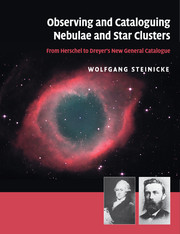Book contents
- Frontmatter
- Contents
- Preface
- 1 Introduction
- 2 William Herschel's observations and parallel activities
- 3 John Herschel's Slough observations
- 4 Discoveries made in parallel with John Herschel's Slough observations
- 5 John Herschel at the Cape of Good Hope
- 6 The time after Herschel's observations until Auwers' list of new nebulae
- 7 Compiling the General Catalogue
- 8 Dreyer's first catalogue: the supplement to Herschel's General Catalogue
- 9 Compilation of the New General Catalogue
- 10 The New General Catalogue: publication, analysis and effects
- 11 Special topics
- 12 Summary
- Appendix
- References
- Internet and image sources
- Name index
- Site index
- Object index
- Subject index
11 - Special topics
Published online by Cambridge University Press: 06 December 2010
- Frontmatter
- Contents
- Preface
- 1 Introduction
- 2 William Herschel's observations and parallel activities
- 3 John Herschel's Slough observations
- 4 Discoveries made in parallel with John Herschel's Slough observations
- 5 John Herschel at the Cape of Good Hope
- 6 The time after Herschel's observations until Auwers' list of new nebulae
- 7 Compiling the General Catalogue
- 8 Dreyer's first catalogue: the supplement to Herschel's General Catalogue
- 9 Compilation of the New General Catalogue
- 10 The New General Catalogue: publication, analysis and effects
- 11 Special topics
- 12 Summary
- Appendix
- References
- Internet and image sources
- Name index
- Site index
- Object index
- Subject index
Summary
The last chapter covers themes, spreading over a large fraction of the nineteenth century and involving many eminent visual observers. Thus it was impossible to treat them in closed form in the above sections. This concerns observation methods, measurements and presentations of some key objects. The topic ‘resolvability of nebulae’ is excluded here, because it is strongly related to William Herschel's ideas about the nature and evolution of nebulae and therefore cannot be separated from the previous text. Section 11.1 treats positional measurements, often made by professional astronomers using refractors with micrometers or meridian-circles. Inspired by the success for stars, it was hoped that it would be possible to detect proper motions of nebulae to determine their distances and spatial distribution. The result was negative, since most objects are too far away and the accuracy of the measuring method was too low. Another, much more debated topic is drawings. Section 11.2 describes the main problem: the subjectivity in perception and presentation of non-stellar objects. Prior to photography, textual descriptions or sketches were the only way to capture the appearance. An important goal was the detection of change concerning form or brightness. This attempt failed as well – the differences due to the observers were too large. A special kind of object was discovered by Lord Rosse in the year 1845: the spiral nebula. The first was M 51, a bright galaxy in Canes Venatici.
- Type
- Chapter
- Information
- Observing and Cataloguing Nebulae and Star ClustersFrom Herschel to Dreyer's New General Catalogue, pp. 472 - 561Publisher: Cambridge University PressPrint publication year: 2010

